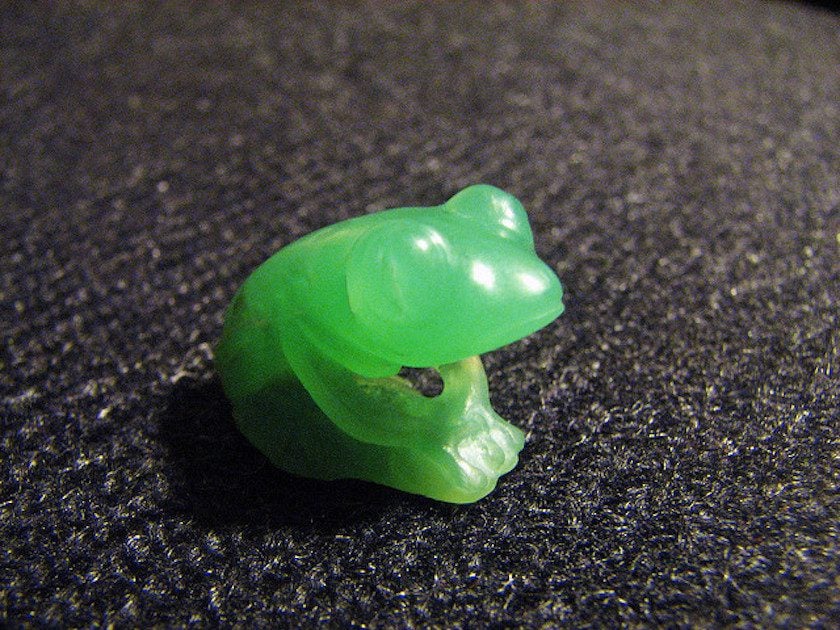Chrysoprase Value, Price, and Jewelry Information
Chrysoprase is apple-green chalcedony that derives its color from nickel. Its hardness and striking color make it a popular gemstone for jewelry as well as carvings.
2 Minute Read
Chrysoprase is apple-green chalcedony that derives its color from nickel. Its hardness and striking color make it a popular gemstone for jewelry as well as carvings.
Start an IGS Membership today
for full access to our price guide (updated monthly).Chrysoprase Value
What is Chrysoprase?
A variety of chalcedony, chrysoprase is a cryptocrystalline quartz gemstone. Transparency ranges from nearly opaque to nearly transparent. Its colors range from apple to olive green and nearly pure greens with medium tones.
Sometimes, you may encounter the term "prase" used to describe chrysoprase gems with darker tones. However, prase is also used to refer to green chalcedonies colored by chlorite inclusions found in Europe.
Does Chrysoprase Make a Good Jewelry Stone?
With no cleavage and a hardness of 6.5-7, chrysoprases make excellent gems for any type of jewelry. However, since some stones may have a hardness below 7, using protective settings for a ring would be advisable. Gems with a hardness below 7 are susceptible to scratches from everyday wear as well as a very common hazard: household dust.
What Gives Chrysoprase Its Color?
While some chalcedony varieties, such as mtorolite from Zimbabwe, may derive their green color from chromium, chrysoprases get their color from nickel.
Are There Synthetic Chrysoprases?
Laboratories can synthesizequartz, including chalcedonies, and this material does appear in jewelry. However, consumers looking for chrysoprases are more likely to encounter simulants, natural gemstones or lab-created materials that look like chrysoprases but with distinct chemistry and/or crystal structures. In fact, the most commonly encountered lookalikes are other varieties of chalcedonies dyed green to simulate these stones.
Chrysoprases themselves may also be used to simulate other, more expensive gemstones. For example, very fine, highly saturated chrysoprases have been misidentified (or intentionally marketed) as "imperial jade." Jadeite pieces will command much higher prices than chrysoprases. Since these two gems have distinctive properties despite appearances, gemologists can readily distinguish these materials.
What is Aquaprase™?
Discovered in Africa in 2015, a blueish green to turquoise-colored chalcedony is being sold under the trade name "Aquaprase™". This material is not a variety of chrysoprase. Rather, it's itself a variety of chalcedony with distinctive gemological properties.
Where is Chrysoprase Found?
Most chrysoprase sold today comes from Australia. The most notable sources from this country include the following:
- Queensland: Greenvale; Marlborough.
- Western Australia: Yandramindra, Wingelina, Kalgoorlie.
Other gem-quality sources include the following:
- Brazil; Kazakhstan; Myanmar; Poland; Russia; Tanzania.
- United States: Arizona; California.
Stone Sizes
Locations near Kalgoorlie, Western Australia have yielded 700 and 1,470 kg nodules.
How to Care for Chrysoprase Jewelry
Dyed chrysoprase jewelry may fade if exposed to sunlight or heat. Natural, untreated chrysoprases from Europe can also fade and dry out if exposed to sunlight. Store European chrysoprases in a dark jewelry box and reserve them for evening wear. If they fade, store them with a moist cloth to restore color. Natural, untreated Australian chrysoprases won't fade in sunlight.
A combination of mild detergent, warm water, and a soft brush is a good choice for cleaning chrysoprases. Consult our gemstone jewelry cleaning guide for more recommendations.
Joel E. Arem, Ph.D., FGA
Dr. Joel E. Arem has more than 60 years of experience in the world of gems and minerals. After obtaining his Ph.D. in Mineralogy from Harvard University, he has published numerous books that are still among the most widely used references and guidebooks on crystals, gems and minerals in the world.
Co-founder and President of numerous organizations, Dr. Arem has enjoyed a lifelong career in mineralogy and gemology. He has been a Smithsonian scientist and Curator, a consultant to many well-known companies and institutions, and a prolific author and speaker. Although his main activities have been as a gem cutter and dealer, his focus has always been education. joelarem.com
Barbara Smigel, PhD. GG
Barbara Smigel is a GIA Graduate Gemologist, faceter, jewelry designer, gem dealer, gemology instructor and creator of the well-regarded educational websites acstones.com and bwsmigel.info.
International Gem Society
Related Articles
Chrysoprase Buying Guide
Does Chrysoprase Jewelry Fade?
Black Diamond Value, Price, and Jewelry Information
Chameleon Diamond Value, Price, and Jewelry Information
Latest Articles
Identifying Synthetic Gems
Ten Big, Beautiful, and Affordable Engagement Ring Stones
Rhodochrosite Value, Price, and Jewelry Information
Ruby and Sapphire Survey: Where Do You Draw the Line?
Never Stop Learning
When you join the IGS community, you get trusted diamond & gemstone information when you need it.
Get Gemology Insights
Get started with the International Gem Society’s free guide to gemstone identification. Join our weekly newsletter & get a free copy of the Gem ID Checklist!
